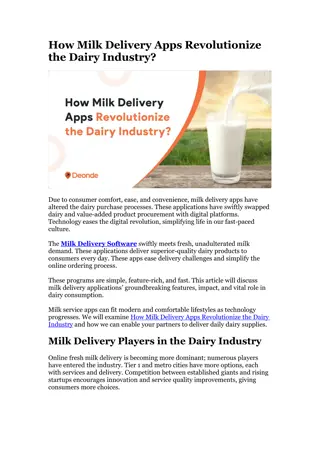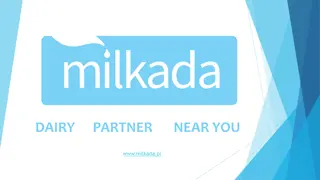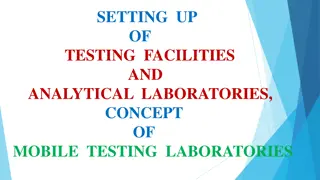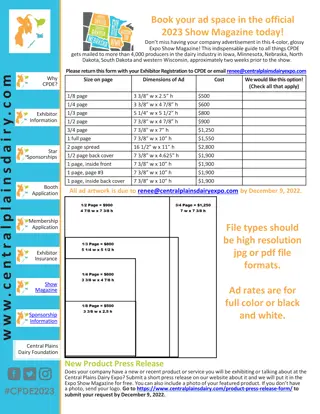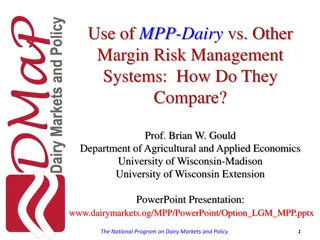Evolving into a Strategic Executive with Philip Mazza, CHRO Byrne Dairy Companies
Philip Mazza, CHRO of Byrne Dairy Companies, shares insights on transitioning from a tactical manager to a strategic leader. With over 35 years of HR experience, he emphasizes understanding senior leaders' perspectives and measuring HR performance effectively. The session focuses on differentiating tactical and strategic responsibilities, aligning HR value with organizational goals, and providing actionable takeaways for professional growth.
Download Presentation

Please find below an Image/Link to download the presentation.
The content on the website is provided AS IS for your information and personal use only. It may not be sold, licensed, or shared on other websites without obtaining consent from the author.If you encounter any issues during the download, it is possible that the publisher has removed the file from their server.
You are allowed to download the files provided on this website for personal or commercial use, subject to the condition that they are used lawfully. All files are the property of their respective owners.
The content on the website is provided AS IS for your information and personal use only. It may not be sold, licensed, or shared on other websites without obtaining consent from the author.
E N D
Presentation Transcript
Getting That Seat at the Table by Someone Who is There Philip Mazza CHRO, Byrne Dairy Companies
Philip Mazza CHRO Byrne Dairy Companies About Byrne Dairy About $1b company Four manufacturing facilities in Central New York Fifty-six convenience stores throughout New York 1,500 employees Partner with major retailers throughout the nation Our ESL and cultured products have a national reach Our employee-base is very diversified in terms of talent, from CDL drivers, to production technicians, maintenance technicians, lab technicians, R&D, engineers, office positions, store staff, etc.,.
Philip Mazza CHRO Byrne Dairy Companies About Me Thirty-five years in Human Resources Worked for large organizations such as Kemper Insurance, Intermedia Communications, and Barnes & Noble Adjunct professor at LeMoyne College Serve on LeMoyne College s Madden Business School Board Served on several Board s of not-for-profit organizations Bachelor degree in Business and an MBA CHRO for Byrne Dairy and a member of its Board of Directors Recently published novelist
Philip Mazza CHRO Byrne Dairy Companies Objective To learn how to move from being a tactical manager to being part of a strategic executive team. 1. Differentiate between the tactical and strategic areas of responsibility in your role. 2. Understand how senior leaders think and what is important to them. 3. Design elements of a system for HR to demonstrate its value to an organization, it must measure its performance against targets.
Philip Mazza CHRO Byrne Dairy Companies At the End of the Session My promise to you . . . I will provide you with a summary of actionable items.
Philip Mazza CHRO Byrne Dairy Companies Are You Delivering ? 1997, Harvard professor Michael Beer shared his thoughts about HR in The Transformation of the Human Resource Function. His premise then was that HR must shift from administrative work to strategic partnership. 1998, David Ulrich asked in HBR, Should we do away with HR? 2005, Keith Hammonds wrote an article in FastCompanyentitled Why we Hate HR. 2013, Ram Charan wrote in HBR about how to fix HR. 2015, Peter Cappelli wrote an HBRarticle entitled Why We Love to Hate HR and What HR Can Do About It All this means that there is a compelling need for our work. But the answer is not changing HR s organizational structure or reporting relationship.
Philip Mazza CHRO Byrne Dairy Companies Are You Delivering ? The Answer . . . 1. The HR body of knowledge is real and highly complex, and it requires practitioners to understand both quantitative and qualitative concepts that apply to the workforce. 2. The crux of the issue is and always has been what every CEO wants to know How well is our workforce performing within business constraints? You can look at the components talent acquisition, pay and benefits, employee relations, learning and development but each of those components must be connected in order to answer the question.
Philip Mazza CHRO Byrne Dairy Companies Differentiate Between the Tactical and Strategic Areas of Responsibility in Your Role 1. You must have a strategic plan that answers the question: How well is our workforce performing within business constraints? 2. Simple format: strategic area, action items, ownership, success measures. 3. The plan s keys are its success measures the quantifiable, from the now to the future. This is you moving the needle; this is your strategic intent. 4. The strategic plan differentiates the tactical v strategic by showing how the tactical supports that burning question. 5. The strategic plan shows that you are proactive v reactive.
Philip Mazza CHRO Byrne Dairy Companies How They Think . . . How They Are Wired 1. Know the link between operating metrics and financial statements. 2. Think strategically. 3. Understand how others view their company; know their competitors. 4. Balance stakeholder needs through value based thinking and long-term interests. 5. Persistence and grit. 6. Vet ideas through the lenses of customer value and investment risk ROI. 7. Intuitive decision makers. 8. Organization design is considered a key strategic issue. 9. Self-aware. 10. Know the priorities. 11. Confident . 12. Have a cause. 13. Have a an ego.
Philip Mazza CHRO Byrne Dairy Companies Let s Re-Wire You . . . 1. Step back and judge whether or not what you have been asked to do is worth it. Do this all the time; get others in your unit to do the same. 2. Question old habits looking for value. That s how we ve always done it, doesn t work. 3. Don t show you are overwhelmed. Figure out how to prioritize and make recommendations. Same goes for your staff. 4. Push back in a way that builds credibility and adds more value. 5. Solve problems, not just report them. 6. Know the cause-effect of your metrics and financial statements. Take a deep dive into variances and report findings. 7. Know what your competitors are doing. 8. Balance employee needs with company requirements. Communication plans are critical. 9. Do not deviate from your strategic intent.
Philip Mazza CHRO Byrne Dairy Companies Understand How Senior Leaders Think and What is Important to Them 1. Talk business, not HR with business managers. 2. Obtain your company s business plans and see where you can help. 3. Talk about business plans, performance, and opportunities. 4. Every meeting about an HR issue is an opportunity to ask questions about the business. 5. Find out how the business measures its performance. Measure your business in the same manner. 6. Show you can fix problems. 7. Build your influence by showing your value through metrics, analytics, and your strategic plan. 8. Publish HR s commercial contributions e.g. cost savings, improved service, value- driven organizational design.
Philip Mazza CHRO Byrne Dairy Companies Your New System 1. Use metrics to show how the HR department helps save money. Numbers talk. Show your executives the different metrics that prove, in black and white, the financial worth of your department. Executives see numbers as a straightforward, proven record of the value your department provides. Reporting on key metrics like workforce productivity, recruiting costs, and retention, and creating specific goals and meeting them are sure-fire ways to develop a strong relationship with the executives at your company. 2. Create an efficient culture. One of the main focus areas of human resources departments is making the company culture more efficient and productive. This is built on things like employee morale and engagement, management satisfaction, and developing processes around recruiting and training that save the company money in ways that other departments aren t able to. By carefully selecting your workforce and developing employee management processes that protect the company against future lawsuits, your department will be able to save your company time and money.
Philip Mazza CHRO Byrne Dairy Companies Your New System 3. Show how HR innovations can change your workplace. The number of new HR technologies currently being used in today s workforce is remarkable. The HR technology industry itself is a $4b market, and it s growing. If your C-suite level executives are wanting the company to innovate and be ahead of the trend, it s important to understand the most valuable part of the company: its employees. The HR department has a very important role in finding and developing the employees who are going to plant and develop the seeds of innovation and growth. 4. Show strategic value in placing employees. When it comes to the strategic direction of the company, HR also plays an important role. Employees are the most important resource in your company. Talent metrics are critical in showing the value of talent acquisition.
Philip Mazza CHRO Byrne Dairy Companies Your New System 5. Predict future company needs through human resources. The great thing about HR data and analytics is that they can help predict the future of your company s human capital needs. The amount of critical data that flows through the HR department can help direct future development. By keeping tabs on productivity and determining how many and what kind of new employees the company will need to hire in the near future and well beyond, HR can provide the kind of forethought that will allow your company to not just survive but thrive in the changing markets to come.
Philip Mazza CHRO Byrne Dairy Companies Design Elements of a System for HR to Demonstrate its Value to an Organization, it Must Measure its Performance Against Targets You must be able to support and enable the execution of strategy through building organizational capability. This is a role that cannot be automated, shared as a service, offshored or outsourced. It comes from an intimate knowledge of a business s strategy and the existing capabilities of the organization. Business process redesign Organizational redesign Job redesign Competency model development Strategic workforce planning Benchmarking Monthly reporting: data . . . metrics . . . predictive analytics . . . variance reporting Department balanced scorecard Personal scorecards
Philip Mazza CHRO Byrne Dairy Companies Action 1. Differentiate between the tactical and strategic areas of responsibility in your role. You must have a strategic plan that answers the question: How well is our workforce performing within business constraints? Simple format: strategic area, action items, ownership, success measures. The plan s keys are the success measures the quantifiable, from the now to the future. This is you moving the needle; this is your strategic intent. The strategic plan differentiates the tactical v strategic by showing how the tactical supports that burning question. The strategic plan shows that you are proactive v reactive.
Philip Mazza CHRO Byrne Dairy Companies Action 2. Understand how senior leaders think and what is important to them. Talk business, not HR with business managers. Obtain your company s business plans and see where you can help. Talk about business plans, performance, and opportunities. Every meeting about an HR issue is an opportunity to ask questions about the business. Find out how the business measures its performance. Measure your business in the same manner. Show you can fix problems. Build your influence by showing your value through metrics, analytics, and your strategic plan. Publish HR s commercial contributions e.g. cost savings, improved service, value-driven organizational design.
Philip Mazza CHRO Byrne Dairy Companies Action 3. Design elements of a system for HR to demonstrate its value to an organization, it must measure its performance against targets. You must be able to support and enable the execution of strategy through building organizational capability. It s a role that comes from an intimate knowledge of a business s strategy and the existing capabilities of the organization. Business process redesign Organizational redesign Job redesign Competency model development Strategic workforce planning Benchmarking Monthly reporting: data . . . metrics . . . predictive analytics . . . variance reporting Department balanced scorecard Personal scorecards
Philip Mazza CHRO Byrne Dairy Companies Q & A Thank you. phil.mazza@byrnedairy.com



